Robert W. Gibson
| Robert Williams Gibson | |
|---|---|
|
Elevation of Morton F. Plant House (1905), now Cartier's, New York | |
| Born |
November 17, 1854 Essex, England |
| Died |
August 17, 1927 Woodbury, New York |
| Nationality | USA |
| Known for | Architect |
Robert W. Gibson, AIA, (1854 in England – 1927 in New York City) was an English-born American ecclesiastical architect active in late-nineteenth- and early-twentieth-century New York City and New York State. He designed several large Manhattan churches and a number of prominent residences and institutional buildings.
Gibson studied architecture at the Royal Academy of Arts, London. He won a competition to design All Saints Cathedral (Albany, New York).[1]
Works
- 1885 Notleymere, Cazenovia (town), New York
- 1888 All Saints Cathedral (Albany, New York)
- 1888 (remodeling) St. Paul's Cathedral (Buffalo, New York)
- 1889-1890 St. Stephen's Episcopal Church (Olean, New York)
- 1890 St. Michael's Episcopal Church (New York City)
- 1892 Federation of Protestant Welfare Agencies
- 1890-92 Music Hall (Sailors' Snug Harbor), Staten Island
- 1890-93, Randall Memorial Church (Sailors' Snug Harbor), Staten Island, demolished 1952.[2]
- 1905 Morton F. Plant House, 651 Fifth Avenue, New York, with C.P.H. Gilbert. Since 1917, this has been Cartier's Flagship Store.
 All Saints Cathedral (Albany, New York), 1888, West facade.
All Saints Cathedral (Albany, New York), 1888, West facade. Snug Harbor Music Hall, 1890–92, Staten Island, New York City.
Snug Harbor Music Hall, 1890–92, Staten Island, New York City.- Morton F. Plant House, 1905. Cartier Jewelers' New York landmark location on 5th Avenue.
Personal
Gibson married in 1890 to Caroline J. Hammond. They had four children: three daughters and a son.[3]
References
| Wikimedia Commons has media related to Robert W. Gibson. |
This article is issued from Wikipedia - version of the 11/12/2016. The text is available under the Creative Commons Attribution/Share Alike but additional terms may apply for the media files.
